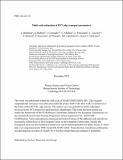| dc.contributor.author | Balbinot, L. | en_US |
| dc.contributor.author | Rubino, G. | en_US |
| dc.contributor.author | Casiraghi, I. | en_US |
| dc.contributor.author | Meineri, C. | en_US |
| dc.contributor.author | Frassinetti, L. | en_US |
| dc.contributor.author | Aucone, L. | en_US |
| dc.contributor.author | Mantica, P. | en_US |
| dc.contributor.author | Innocente, P. | en_US |
| dc.contributor.author | Wigram, Mike | en_US |
| dc.contributor.author | JET contributors | en_US |
| dc.contributor.author | Alcator C-Mod Team | en_US |
| dc.date.accessioned | 2025-03-21T20:24:56Z | |
| dc.date.available | 2025-03-21T20:24:56Z | |
| dc.date.issued | 2022-12 | |
| dc.identifier | 22ja111 | |
| dc.identifier.uri | https://hdl.handle.net/1721.1/158761 | |
| dc.description | Submitted for publication in Nuclear Materials and Energy | |
| dc.description.abstract | The main goal of the Divertor Tokamak Test facility (DTT) is to operate with a high value of power-exhaust relevant parameter PSOL/R in plasma scenarios similar to those foreseen for the Demonstration Fusion Power Plant (DEMO) in terms of low collisionality and neutral opacity. For these unique characteristics, accurate modelling of the principal scenario is necessary for machine designing. In edge numerical codes, cross-field transport profiles have a high impact on modelling results. This work aims at providing a coherent set of transport parameters for DTT full-power (FP) single-null (SN) scenario edge modelling. To evaluate such parameters for DTT, a transport analysis on the current machine has been performed using SOLEDGE2D-EIRENE and SOLPS-ITER. The transport parameters to be used in the simulations of the DTT single-null scenario were selected using two complementary methods. The first is the modelling of JET and Alcator C-Mod (C-Mod) with SOLEDGE2DEIRENE and SOLPS-ITER, validating transport parameters by comparing modelling results to experimental data from pulses which are considered DTT-relevant. JET pulses were selected with the highest auxiliary input power (from 29 to 33 MW), plasma current and toroidal field to better match DTT parameters; nitrogen and neon seeded pulses were selected to check possible seeding material dependencies. The considered C-Mod pulse better matches DTT plasma density and neutral opacity. Transport parameters are then scaled to DTT according to scaling laws. The second method derives the transport parameters by tuning their values inside the DTT separatrix to reproduce the pedestal profiles predicted by the EPED model via the Europed code and applied in DTT. The derived set of DTT transport parameters is consistent with the results obtained by modelling present machines, reproduces the expected heat flux decay length in detached conditions and, inside the separatrix, reproduces the predicted pedestal using transport parameters which are coherent with what is predicted by the quasi-linear turbulent model QuaLiKiz. | |
| dc.publisher | Elsevier | en_US |
| dc.relation.isversionof | doi.org/10.1016/j.nme.2022.101350 | |
| dc.source | Plasma Science and Fusion Center | en_US |
| dc.title | Multi-code estimation of DTT edge transport parameters | en_US |
| dc.type | Article | en_US |
| dc.contributor.department | Massachusetts Institute of Technology. Plasma Science and Fusion Center | |
| dc.relation.journal | Nuclear Materials and Energy | |
